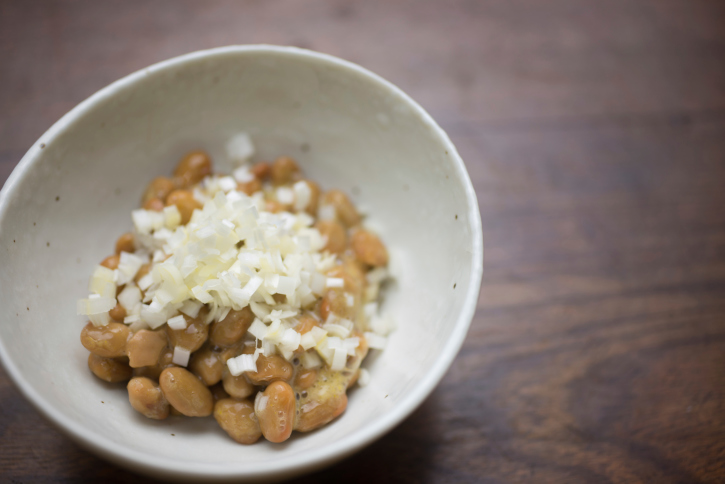Q: I have seen warnings about soy and have been avoiding it. But I have also seen mention of Natto, a fermented soy, as a super food. Should Natto be avoided?
Oh natto… you bizarre, slimy little superfood. With all the great research coming out about vitamin K2 these days, more and more interest has been developing in this traditional Japanese staple. But what the heck is natto, and why would anyone touch a soy food with a ten-foot pole? (After all, soy is so not “Paleo”… right?)
Natto is a popular food in Japan that’s often eaten at breakfast. It’s a fermented soy food with a strong smell that some people described as musky and similar in pungency to ripe cheese, and it has a strong, nutty and salty flavor and a slippery texture.
I was able to try some at the last Weston A. Price Foundation conference, thanks to Dr. Kate Rheaume-Bleu, and I found it to be far more tolerable than I expected. (I wouldn’t say I loved it, but I expected it to be far more… disgusting?)
If you’re curious, Dr. Weil explains how it’s made:
To make natto, soybeans are soaked overnight and then steamed for about an hour. Next they’re sprinkled with powdered natto bacteria (Bacillus subtilis) and allowed to ferment for up to 24 hours. It then must be cooled and aged for at least a week to allow the flavor and texture to develop.
The most beneficial part of natto is its high vitamin K2 content, thanks to the bacterial fermentation of the soybeans. As many of you know, vitamin K2 is crucial for calcium metabolism and keeping calcium in the bones and out of the arteries. Natto is one of the best sources of vitamin K2 in the world, so that alone is a great reason to eat it if you like it.
It also contains an enzyme called nattokinase which is thought to help prevent blood clots, and is actually sold as a supplement. In general, natto seems to be a very heart healthy food and could be a big reason why the Japanese used to have a lower risk for heart disease (though the Westernization of their diet is changing that.)
The important thing that differentiates natto from other commonly consumed soy products like tofu and soymilk is that it’s fermented, which helps to break down the anti-nutrients contained in soy like phytates, making it more digestible. Fermentation also increases the bioavailability of isoflavones, which are thought to protect against cancer.
Would you like to save this post?
Your email address is 100% safe and will never be sent spam.
The fermentation process also introduces probiotics into the food, which help to process nutrients and make them easier to absorb and utilize. That’s why the vitamin K2 content of natto is so high. Some other traditionally fermented soy products include miso, tamari or shoyu, which is a fermented 100% soy sauce, and tempeh, which is sometimes used as a meat substitute.
These foods are far different than the types of soy foods we often consume in the united states, such as soy protein isolate and soy milk, which are made with GMO, pesticide covered crops that have been produced in a completely industrial, non-traditional manner.
Truthfully, I think that most people can include moderate amounts of traditionally prepared soy products in their diet if they want to. Personally, I enjoy having traditional tamari when I eat sushi, and I’ve tried tempeh in the past and actually liked it.
That said, natto is not necessarily a food that I plan to eat on a regular basis, based on availability and taste preferences. As a European descendent living in a Western culture, I choose to get my vitamin K2 from grass-fed butter, yogurt, cheese, and a high quality vitamin K2 supplement. Those foods are far easier for me to find and eat than something like natto!
I don’t think people need to be afraid of traditional soy foods, but soy foods are not an essential component of a healthy diet either. If you like natto and tolerate it well, then that’s great – by all means you should eat it regularly since it’s a very healthy food.
But otherwise, I think this is another situation where you need to consider your own preferences and decide whether or not its something worth seeking out and including in your diet.
Obviously those with a soy allergy need to avoid these foods, but ultimately natto is a traditional, properly-prepared soy food that contains a variety of beneficial nutrients that may support health, particularly cardiovascular health.
Do any of you eat traditional soy products? Share your story in the comments below!
This post may contain affiliate links. If you click on a link and make a purchase, I may receive a small commission.

+ show Comments
- Hide Comments
add a comment